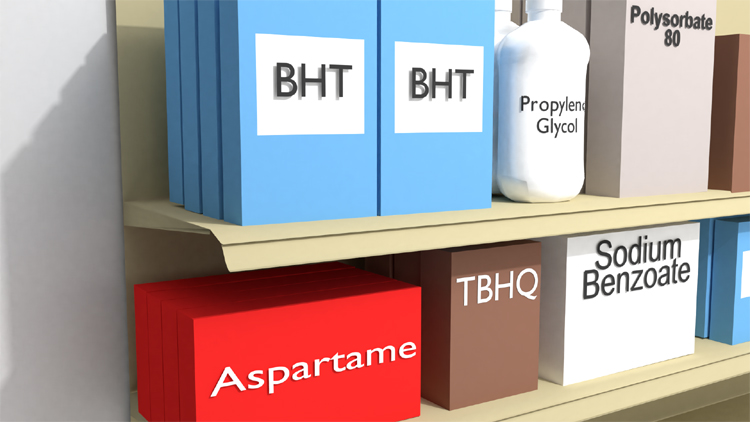None of These
Ingredients


By: David Deschesne
Editor/Publisher, Fort Fairfield Journal
March 11, 2020
Have you ever noticed that home-baked foods like bread and pastries don’t last nearly as long as store-bought items before growing mold?
My homemade bread, which is essentially flour (King Arthur’s only, for me), salt, yeast, brown sugar (only a pinch) and lard only lasts for a couple of days before mold starts growing on it. I add no preservatives or other shelf-life extending ingredients, like the factory foods do. Nor could I; most of those additives are not available to consumers. They’re only sold in bulk by the barrel, crate or rail car to food processors.
I’m not going to discuss diets here, or which foods are the best, only to mention that the USDA’s food pyramid was built out with processed wheat to keep the food stamp program costs down by coaxing consumers and organizations that receive government money to substitute the more expensive fresh fruits and vegetables for the cheaper, processed white wheat flour which causes diabetes and obesity when eaten in the amounts suggested by the U.S. government. I’m digressing already, I’ll make this a topic for another editorial.
What I am going to do here is take a look at the ingredient lists of some of the most common processed foods sold in grocery stores and supermarkets today and try to note some of the non-food ingredients that we eat and show how they are probably not the best for us if we want to maintain a healthy body and immune system with the resultant decrease in health care costs that would come along with eating cleaner, healthier foods.
Most of the foods these ingredients come in are the brand name, and store brand foods that - while getting more expensive by the week due to our minimum wage increases - are typically the bottom end garbage that the wealthy elitists who produce it won’t even touch. The healthier, more expensive food doesn’t contain all these garbage chemicals but it doesn’t last as long on the store shelves, either.
While you may pay less for processed foods with all these additives in it, at the end of the day you - and even society - pays more in higher health care costs as people attempt to repair their bodies after they’ve been wrecked by chemical additives.
Keep in mind, these additives weren’t added arbitrarily. They’ve been approved by the U.S. government through the Food & Drug Administration (FDA). That doesn’t mean much for safety, though. The FDA functions merely as a protection racket for mega-corporate agriculture giants by suppressing competition and ensuring cheap food at the expense of the health of consumers. Not much of the food additives or drugs deemed “safe” by the FDA are in fact safe; all that label means is the corporation seeking that status has likely paid enough in the form of under the table bribes to both Congressmen and the FDA officials themselves to get their product accepted. In many cases, the FDA inspectors got hired into that job from the corporate agricultural-industrial complex so they have a wink-and-nod friendly attitude toward those they are overseeing in the corporate world. This is how most of this junk got added into our food. It stays in there because consumers keep buying it and eating it, regardless of what it does to their health and well-being.
Some of the more esoteric, or even non-food ingredients I’ve noted are:
Hydrogenated Vegetable Oil
This is some form of liquid vegetable oil such as canola, corn, or the most popular - soybean - that has by an artificial process had an extra hydrogen atom added to it. The effect is to solidify it so it resembles solid fat like beef fat (tallow) or pork fat (lard). It is widely used as the base ingredient of vegetable shortening, margarine, peanut butters (the cheap, non-natural brands), breads, and as an artificial cream in pastries and most mass-produced cookies, deserts and cake frostings. Hydrogenated Vegetable Oil is only one atom away from being pure plastic. It is a non-food. It has no nutritional value and has been shown to cause hardening of the arteries and heart disease - two problems it was supposed to solve by replacing natural fats like butter and cream in the diet. Due to its incredibly low cost, it remains popular as a food additive and butter substitute (margarine), but becomes expensive when considering the high health care costs that result after consuming it over long periods of time.
TBHQ
Tertiary Butylhydroquinone (TBHQ), is a man-made, chemical antioxidant which is added to foods to prevent the oxidation which causes loss of flavor. It is commonly used in foods such as crackers, microwave popcorn, butter and chicken nuggets. Due to health concerns, it has been banned as a food additive in some European countries, but the FDA continues to allow its consumption in the U.S. TBHQ is one of the primary ingredients in the commercially produced “Play - Dough” children's arts and crafts toy.
Propylene Glycol
Propylene Glycol is a form of anti-freeze which also can be used as hydraulic fluid. It is man-made and does not exist in nature, much less in any naturally grown edible foods.
In addition to its being used in the paint manufacturing process, artificial smoke and e-cigarettes, it’s also used in injectable medications, creams and ointments and assorted water-based “personal lubricants.”
Propylene glycol is widely used as a food additive as an antioxidant, stabilizer and thickener. In the past it was ubiquitous in salad dressings, condiments and cheap, budget-priced pastries. Most of those producers, responding to consumer pressure, have removed it from those products, though. But a derivative of it can still be found widely used in nearly all brand-name cake mixes on store shelves today - masquerading as “propylene glycol mono and diesters of fatter acids.”
The body views propylene glycol as a toxin and filters it out; accumulating it in the body’s “blood filter” - the liver - nearly for life.
Aspartame
Aspartame is a commercially produced artificial sweetener containing the amino acid phenylalanine (which occurs naturally in the body) and methyl alcohol - also known as “wood alcohol” and is the dangerous alcohol to drink.
When aspartame reaches above 80 degrees F it separates into its component parts. Nearly all “diet” soft drinks and “no sugar” candies and chewing gum contain this dangerous sweetener. It is also contained in the “no sugar” puddings and many powdered drink mixes.
In the late 1990’s, Monsanto patented a process where aspartame can be mass produced cheaply by collecting the waste product/fecal matter of e. coli bacteria. The cultivated and well-fed bacteria produce proteins which contain the aspartic acid-phenylalanine amino acid segment required to produce the sweetener.
While it’s touted as a “weight loss” low sugar substitute, consumption of aspartame actually increases the body’s craving for carbohydrates, thus causing more weight gain than would have been realized than if just plain sugar was used. The ultimate negative health effects of consuming aspartame, then, are obesity, high blood pressure and heart disease. Soft drinks that contain no sugar, and the preservative, sodium benzoate, are more likely to cause the sodium benzoate to break down into the known cancer-causing carcinogen, benzene.
Sodium Benzoate
Sodium benzoate, C6H5COONa, is a preservative added to mass-produced soft drinks, packaged foods, and personal care products to prolong shelf life. A large concern over the use of sodium benzoate is its ability to convert to benzene, a known carcinogen. Benzene can form in soda and other drinks that contain both sodium benzoate and vitamin C (ascorbic acid). Diet beverages are more prone to benzene formation, as the sugar in regular soft drinks and fruit drinks may reduce its formation. Other factors, including exposure to heat and light, as well as longer storage periods, can increase benzene levels.
There are a wide variety of soft drinks now produced without sodium benzoate added. They are generally found in larger grocery stores that feature an “organic” or “all natural” food department. They may cost a little more, but taste better and are less destructive to the body.
BHT
Butylated hydroxytoluene (BHT), is an organic compound derived from phenol. It is widely used for its antioxidant properties. U.S. regulations allow it to be used as a food additive. Additionally, BHT is widely used to prevent oxidation in gasoline and fuel oil. Many of America’s favorite cereal brands contain a small amount of BHT to prevent the vegetable oils in their ingredients from going rancid. BHT is also commonly added to the plastic or wax paper liner of the packaging. From there, it migrates into food.
Polysorbate 80
Polysorbate 80 is from a class of emulsifiers used in some pharmaceuticals and food preparation. It is a synthetic compound made from polyethoxylated sorbitan (compounds derived from dehydrated sugar alcohol.) Polysorbate 80 is used as an emulsifier or defoamer in foods, vitamins, medicines, and vaccines. It is also used extensively in dairy products that claim to be “ultra pasteurized.” One name brand heavy whipping cream claims to have “no preservatives,” but lists Polysorbate 80 as an ingredient. It is used as a defoamer for the fermenting process of some wines, and also to bind some ice-creams and other ‘puddings’, to keep their creamy texture without separating. It is also used to bulk foods up and keep sauces smooth. It can also act as a surfactant in soaps and cosmetics, as well as helping to dissolve ingredients so that they can more easily blend together. It makes products look creamier and more attractive.
There are many more artificial chemical additives added to our food, too numerous to list and explain here.
While there is a shift toward natural foods without chemical additives and genetically modified plants, too many consumers continue to buy the garbage, so it’s the garbage that’s going to be stocked on store shelves.
If you want to be healthier and lower your health care costs, reduce hospital stays, increase your immune system and overall just feel better, start reading the labels on the food you buy. If you find something with toxins in it that you shouldn’t be eating, simply put it back on the shelf and look for something healthier.






